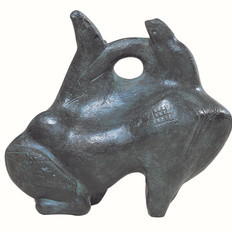
Exposição
São Luís hosts, for the first time, an exhibition with works by Victor Brecheret
30 January to 27 April 2024
Victor Brecheret (1894-1955) was a leading figure in Modernism and his interest in indigenous themes was linked to his desire to produce art with Brazilian characteristics. His work will be on display at the traveling exhibition Brecheret Modernist – The Indigenous Image as a Symbol of Brasility, which will open on January 30 at the Vale Maranhão Cultural Center. On the opening date, at 19:30pm, there will be a guided tour by the exhibition’s curator, professor and art historian, Maria Izabel Branco Ribeiro.
Sponsored by the Vale Cultural Institute, through the Federal Cultural Incentive Law, the Victor Brecheret Institute project brings together about 30 sculptures and 20 original drawings, as well as works and reproductions signed by other artists with similar interests. The exhibition provides an overview of the Italian-Brazilian artist’s trajectory focusing on the formation of Brecheret’s plastic language, his links with modernist proposals and his interest in the indigenous universe.
According to curator Maria Izabel Branco Ribeiro, while highlighting the facet of Brecheret’s Modernism, the exhibition also aims to reverberate, in a wider spectrum, the concern of several artists who, at the beginning of the 20th century, yearned for art with Brazilian characteristics. The sculptor’s integration into the Modernist group is represented by two works participating in the 1922 Modern Art Week exhibition: “Idol” and “Sóror Dolorosa”, the latter executed based on a poem by Guilherme de Almeida
The indigenous theme already appeared in Brecheret’s work in the early 1920s, when, when composing the model for the Monument to the Flags, he decided to include indigenous and mixed race groups. After a season abroad, Brecheret returned to Brazil in 1936.
The accounts of the expeditions of the Villas Boas brothers starting in the early 1940s motivated the artist’s interest in the peoples of Central Brazil and the Amazon, both in relation to myths, customs, and interactions with nature, and to plastic patterns. “The language developed from then on became so efficient that Brecheret used it in other works, such as in a San Francisco”, exemplifies Maria Izabel.
São Luís (MA) is the third city to host the exhibition, which has already visited Belo Horizonte (MG) and Belém (PA). The Vale Maranhão Cultural Center is located at Rua Direita, 149, São Luís Historic Center and is open from Tuesday to Saturday, from 10 a.m. to 7 p.m., with free admission.
About the Artist
Victor Brecheret (1894-1955) was an Italian-Brazilian sculptor, considered the introducer of modern art in Brazilian sculpture. In the year 1922, she participated in the emblematic Modern Art Week. He received the National Sculpture Prize at the 1st São Paulo Biennial in 1951 with the work “the Indian and his açuapara”. He is also the author of the work “Monument to the Flags”, located in Ibirapuera Park (capital of São Paulo). In 1955, he exhibited at the 3rd São Paulo International Biennial and, in 1957, he was posthumously honored with a
special room at the 4th Biennial.
Curatorship
Curator of the exhibition, Maria Izabel Branco Ribeiro from São Paulo has a degree in Arts and a doctorate in Art History. He has experience in the area of museums, curating and organizing exhibitions; researches issues related to collections, modern and contemporary art, preservation of cultural heritage, art
and Brazilian culture.